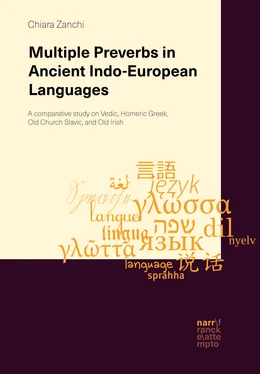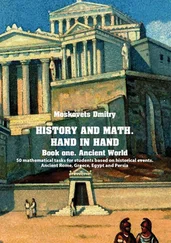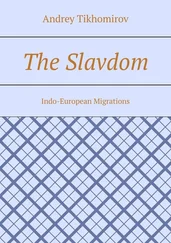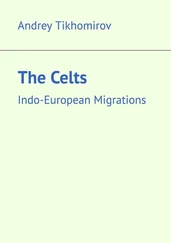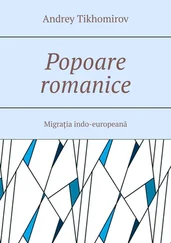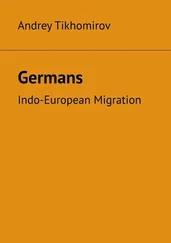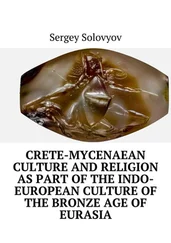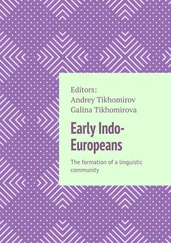2 #N(E) …PV(…)# (cf. (15)b). This type of tmesis is difficult to detect, as the preverb immediately precedes the verb, though the two are only juxtaposed, and do not constitute a single word. This type of tmesis is also allowed in Hittite, Homeric Greek, and Archaic Old Irish.
3 #N(E) …VP(…)#, as in (16). In this passage, the preverb sám ‘with’ occurs in post-verbal position, and adds a telic nuance of meaning to the simplex verb. Watkins suspects this pattern of possibly being a purely poetic innovation of Vedic and Homeric Greek. This pattern is also called “reverse tmesis” or “verbal anastrophe” (cf. Petit 2017).

Later on, preverbs underwent what Watkins descriptively labelled as univerbation (Watkins 1963, 1964). In other words, preverbs developed into bound morphemes, prefixes inseparable from the verb, occasionally with concomitant stress shifts, phonetic erosion, or even ultimate disappearance. Pinault (1995) represents the grammaticalization path covered by preverbs as in (17).
1 independent preverb > left member of a verbal compound > prefix > (zero)
The path in (17) can be illustrated through Latin preverbs. Commenting on some passages from early Latin prayers, Cuzzolin (1995) and Vincent (1999) discuss the fact that, while in Early Latin preverbs must be analyzed as independent constituents, these morphemes later on became left members of verbal compounds, and eventually developed into (bound) prefixes. These stages can be discerned based on two remarks on the early prayers by the grammarian Festus (Cuzzolin 1995: 130; Vincent 1999: 1118):
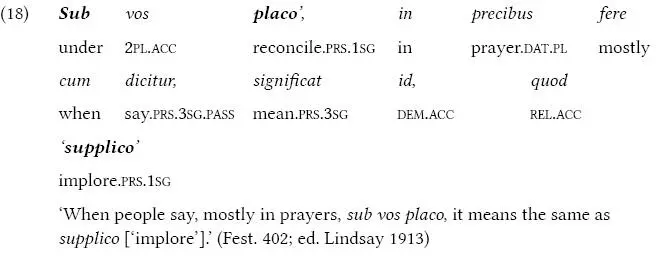



Festus points out that, though in the early varieties of Latin sub ‘under’ and ob ‘to, toward’ could occur outside the immediate preverbal context, these displaced preverbs already constituted single lexical units with the verbs placo ‘reconcile’ and sacro ‘consacrate’ . Festus’ remark finds an effective reformulation in Romagno (2004: 68): “univerbation is only the end point of a grammaticalization, whose semantic effects are far earlier visible.” Accordingly, Cuzzolin (1995: 133) sets out to replace the misleading term “tmesis” with costituenza discontinua ‘discontinuous constituency’: in fact, there are no univerbated compounds proper to ‘cut apart’; rather, preverb-verb discontinuous and continuous combinations are on their way to actual univerbation. Even if displaced, preverbs can modify the semantics of simple verbs, adding spatial or aspectual information: the meaning of the resulting composites can no longer be considered strictly compositional. Going back to (18)–(19), how can the meanings of supplico ‘kneel down/humble one’s self, pray/beg humbly, beseech, implore, supplicate’ and obsecro ‘beseech, entreat, implore, supplicate, conjure’ be straightforwardly derived from sub + placo and ob+sacro ?
Along the path of development in (17), preverbs can partially or entirely lose their local and concrete meanings (De Angelis & Gasbarra 2010: 153): for example, sub no longer means ‘under’ in supplico , just as ob no longer means ‘to, toward’ in obsecro. To be sure, univerbation does not necessarily imply semantic bleaching: both in Sanskrit and in Classical Greek, verbal composites can be fully univerbated but still retain spatial and compositional meanings. Thus, the so-called tmesis attests to a step within the grammaticalization process in (17), in which an independent morpheme has started gravitating toward a verbal stem and modifying it semantically, but does not yet constitute a bound morpheme with it.
Examples from Vedic (15) and Latin (18)–(19) represent two different stages in the historical development of preverbs: on the one hand, we a have a tmesis in which full lexical word(s) intervene(s) in between the preverb-verb combination. On the other hand, the Latin composites are split only by an enclitic pronoun. Precisely considering the type of material (lexical vs. grammatical) that interrupts the preverb-verb combinations, Bertrand (2014) distinguishes “lexical” and “non-lexical tmeses” (“non-lexical tmesis” also being called “clitic interposition”). Arguably, lexical tmesis mirrors a less advanced stage along the continuum toward the univerbation and grammaticalization than that attested by non-lexical tmesis, as I explain below.
One among the few generally accepted syntactic statements about Indo-European is Wackernagel’s law, claiming that enclitics originally occupied the second position in the sentence (Watkins 1964: 1036). Wackernagel’s formulation is based on the evidence from Greek, Indo-Iranian, and Latin; its existence is also evinced in Celtic, and, abundantly in Anatolian and Balto-Slavic. Arguably, in cases of non-lexical tmesis, composites are “split”, exactly because the tendency toward univerbation gives way to the stronger Wackernagel’s law. In this light, non-lexical tmesis is a weaker indicator of independent constituency than lexical tmesis and is allowed by a wider range of languages than those outlined above, including Hittite, Gothic, Old Irish, Lithuanian, and Ossetic for example:
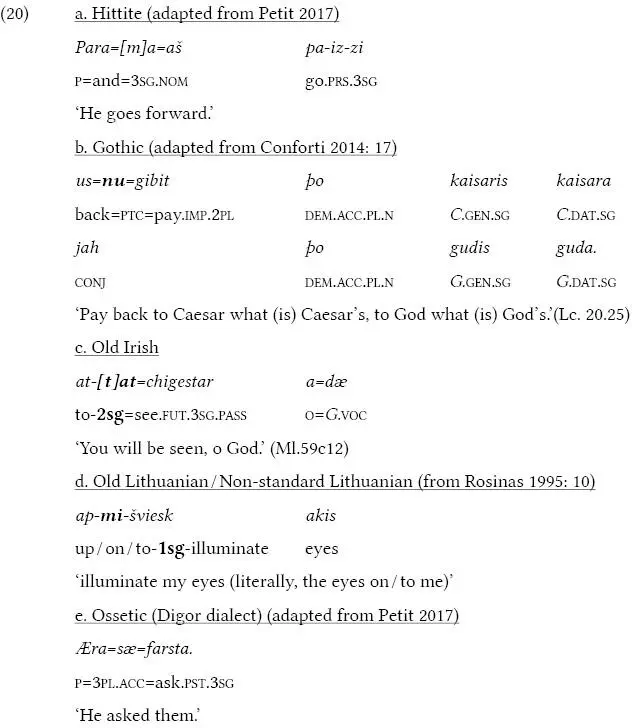
In (20)a from Hittite, the interposition of the clitics =ma= ‘and’ and =aš ‘he’ occurs in between para- …paizzi ‘he goes forward’. In (20)b from Gothic, the enclitic connective =nu intervenes between the preverb us- and the verb =gibit (for a thorough catalogue of the elements that can occur in tmesis position in Gothic, cf. Conforti 2014). In (20)c from Old Irish, a second person enclitic pronoun separates at- ‘to, toward’ from =chigestar ‘will be seen’. In (20)d from Old/Non-standard Lithuanian, a first person pronoun encoding the animate Goal-participant ‘cuts’ the composite (in Modern Standard Lithuanian, reflexive pronoun only can occur in tmesis position; cf. Chapter 6). In (20)e from Ossetic, the composite æra= …=farsta ‘he asked’ is split by the interposition of the clitic = sæ= ‘them’.
Composite verbs and movable preverbs of some modern Germanic languages, in particular West-Germanic, which have received attention in the recent literature (cf. e.g. Ackerman & Webelhuth 1998; McIntyre 2000, 2001a, 2001b, 2003; Dehé and Wanner 2001; Lüdeling 2001; Zeller 2001; Booij 2002a, 2002b; Dehé et al. 2002; Van Kemenade & Los 2003), seem to represent a different development. Van Kemenade & Los (2003: 79ff.) call the productive preverb-verb combination in such languages “separable complex verb”. “Separable complex verbs in the present-day West-Germanic languages typically consist of a verbal base, and a non-verbal part, often but not always a ‘particle’” (Van Kemenade & Los 2003: 80). Such a prefix/particle is part of a separable complex verb that, though constituted by morphemes separable by syntactic processes, operates as a single lexical unit. Dutch and German, for example, feature two different word orders, specifically SVOP in main clauses (21)a, and SOV in subordinate clauses (21)b. By way of example, consider the Dutch verb op-bellen ‘call up’ in (21)a-b:
Читать дальше
